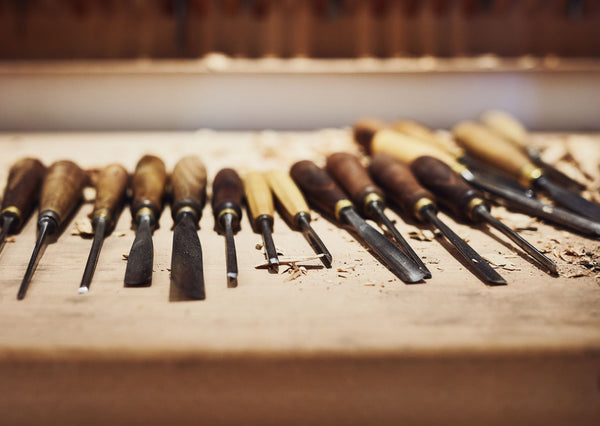Japanese Chisels: The Complete Woodworker’s Guide

Jump to:
Japanese chisels have earned a special place in the hearts of woodworkers worldwide. Renowned for their craftsmanship, razor-sharp edges, and durability, they embody both function and tradition.
Ask any experienced woodworker and they’ll tell you: chisels are the soul of a workshop. In Japan, however, they represent more than just tools, they reflect centuries of refined technique and cultural heritage.
Unlike their Western counterparts, Japanese chisels are forged by laminating hard steel with softer iron. This unique construction gives them exceptional edge retention while maintaining a balanced, responsive feel in the hand. They also follow the Japanese Industry Standard (JIS), so you know you’re getting consistency and quality.
This guide is here to walk you through everything you need to know: the different types of Japanese chisels, how to pick the right set, and where to find reliable brands. We’ll also cover how to sharpen and care for your chisels properly, plus some tried-and-true tips for using them on detailed joinery like dovetails.
What Is The Japanese Industry Standard?

We mentioned just now that Japanese chisels follow the JIS standard. The Japanese Industrial Standards are nationally recognized specifications that help ensure precision, reliability, and consistency across a wide range of industries, including woodworking.
For Japanese chisels and other woodworking tools, JIS plays a key role in defining material quality, dimensional tolerances, hardness, and performance characteristics.
This means tools made to JIS standards are not only crafted with exceptional attention to detail, but also maintain uniform fit and function, which is especially important for joinery and fine handiwork.
For both professionals and serious hobbyists, JIS compliance offers peace of mind that a tool will perform as expected, last through years of use, and pair well with other precision instruments or hardware. In short, it’s a quiet but crucial foundation behind the excellence that Japanese woodworking tools are known for.
Main Types of Japanese Chisels
Japanese chisels come in a wide variety of forms, each designed for specific tasks in woodworking. Some of the most common include:
Oire-Nomi (Bench Chisel) – versatile, everyday chisel for joinery.

Ashi-Nomi (Paring Chisel) – slim, hand-guided chisel for delicate trimming.

Tataki-Nomi (Heavy-Duty Chisel) – robust tool for mortising and heavy striking.

Waki-Nomi (Side Chisel) – beveled sides for cleaning inside corners.

Mentori-Nomi (Chamfer Chisel) – angled edge for decorative bevels.

These are just a few examples, there are also flat chisels, gouges, mortise chisels, and cranked-neck chisels, each serving a unique purpose in joinery and finishing.
For a complete breakdown of all the main Japanese chisel types and their uses, check out our dedicated article: Types of Wood Chisels.
Selecting The Right Japanese Chisel Set

Choosing the right Japanese chisel set depends on your experience level, woodworking style, and the type of joinery you plan to pursue.
For beginners
A basic set of Oire-Nomi in common sizes such as 6mm, 12mm, and 24mm is a practical and versatile starting point, well-suited to most general woodworking tasks without the complexity of more specialized tools.
These chisels are typically easier to maintain and use, especially if made from laminated white or blue steel, which offers a good balance of edge retention and ease of sharpening. A solid hardwood handle with a properly fitted hoop will also help ensure durability when struck with a mallet.
For Professionals and Hobbyists
As skills advance, professionals or dedicated hobbyists may wish to expand their toolkit with specialized chisels like Tataki-Nomi for heavy mortising, Ashi-Nomi for delicate paring work, and Kote-Nomi for angled or precision detailing.
At this level, attention to detail becomes more important and features such as flat backs, finely shaped bevels, consistent tempering, and overall fit and finish will noticeably affect performance and accuracy. Regardless of your skill level, it’s also important to consider the amount of setup required, as some chisels come ready to use out of the box while others require tuning and sharpening.
Ultimately, select a set that matches your current needs but is also capable of growing with you, one that offers both reliability for everyday tasks and the precision needed for more advanced work.
Top Recommended Japanese Chisel Brands

Japan is home to a wide range of chisel manufacturers, from revered master blacksmiths to established industrial brands, each catering to different skill levels and budgets.
At the high end, makers like Tasai, Ouchi, and Ichihiro are celebrated for their hand-forged chisels crafted from laminated white or blue steel, offering exceptional edge retention, balance, and fine detailing.
- Tasai in particular is known for its Damascus-style layering and ornamental finishes, making its chisels prized by professionals and collectors alike.
- Koyamaichi strikes a balance between quality and affordability, offering traditionally forged chisels that are accessible to serious woodworkers.
- Brands like Vessel, Dogyu, and Kakuri cater to a broader market, offering mass-produced chisels that are ideal for beginners, DIYers, or those looking for good performance at a more affordable price point.
- Vessel, better known for screwdrivers and hand tools, produces reliable chisels that are durable and user-friendly. This slotted chisel screwdriver doubles as both a chisel and a screwdriver.
- Dogyu specializes in construction-grade tools and offers robust chisels suited for on-site carpentry and heavier tasks. This duct cutter and spot welding chisel is especially useful both for clearing welding spatter, and cutting holes in square or flat ductwork.
- Kakuri is another trusted name for entry-level and mid-range tools, with a wide range of chisels and woodworking equipment designed for functional everyday use, including this set of three chisels.
Keeping Your Chisel In Tip-Top Condition

Maintaining Japanese chisels requires consistent sharpening, proper storage, and careful handling to preserve their sharpness and precision.
Use flat whetstones, preferably waterstones, starting with a coarse grit to shape the bevel and progressing to finer grits for honing, while keeping the bevel angle around 30 degrees. Just as critical is flattening and polishing the back, which ensures clean, accurate cuts, particularly in joinery work.
After sharpening, remove any burrs and apply a light coat of oil to prevent rust, especially given the high-carbon steel’s sensitivity to moisture.
Store chisels in a wooden box or tool roll to protect the edges from damage, and avoid prying or twisting motions, as these tools are built for clean slicing rather than brute force.
With a little regular care, like keeping the hoop seated and the tang tight, your chisels will stay razor-sharp and ready for precise, refined work.
Tips For Dealing With Detailed Joinery

Japanese chisels are an ideal choice for fine joinery, especially when working with precision cuts like dovetails. Their razor-sharp edges, refined geometry, and responsive handling give woodworkers the control needed for clean, accurate results.
The Oire-Nomi is a go-to tool here, offering a compact form that excels at tight-paring work. A distinctive feature of many Japanese chisels is the slightly hollow back, which simplifies flattening and contributes to snug-fitting joints.
For dovetail work in particular, the combination of a narrow bevel and robust laminated steel blade allows for precise waste removal without edge chatter or deformation.
For even more finesse when trimming near layout lines or cleaning corners, adding a Waki-Nomi or Ashi-Nomi into the mix can enhance accuracy and control.
Japanese Chisels: Always The Right Tool For The Job

Japanese chisels embody tradition, precision, and craftsmanship. From carving mortises to refining dovetails, they offer unmatched control, sharpness, and balance.
Forged with laminated steel and ergonomic design, these tools reflect centuries of mastery. More than just equipment, they foster a deeper connection to your craft.
Choosing the right chisel, maintaining it with waterstones, and caring for it properly transforms even an entry-level tool into a lifelong companion that improves with every project.
Discover the tools trusted by Japanese artisans. Browse our collection of chisels and woodworking essentials to refine every detail of your work.

0 comments